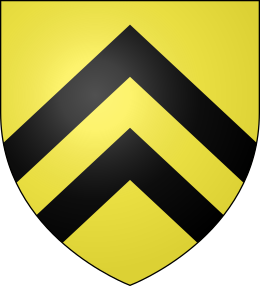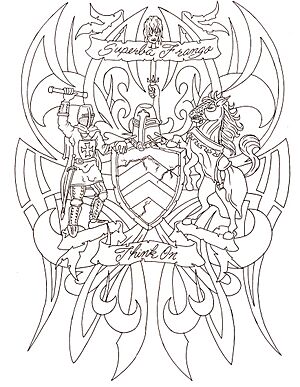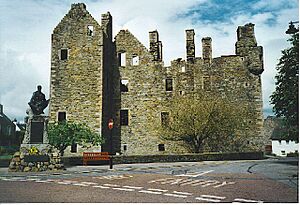Clan MacLellan facts for kids
Quick facts for kids Clan MacLellan |
|||
|---|---|---|---|
| Mac-a-ghille-dhiolan – (son of the bastard) | |||
 |
|||
| Motto | Think On Sapit Qui Reputat Superba Frango |
||
| Profile | |||
| Region | Galloway | ||
 |
|||
| Clan MacLellan has no chief, and is an armigerous clan | |||
| The 10th Lord Kirkcudbright | |||
| Historic seat | MacLellan's Castle | ||
| Last Chief | The Rt. Hon. Camden Gray Maclellan | ||
| Died | 1832 | ||
|
|||
|
|||
|
|||
|
|||
The Clan MacLellan is a Scottish clan from the Scottish Lowlands. Today, the clan does not have an official chief. Because of this, it is known as an Armigerous clan.
Contents
History of Clan MacLellan

Where the MacLellans Came From
The name MacLellan comes from a Gaelic phrase. It means something like "son of the follower of Dhiolan." This name first appeared in records around 1273.
The clan's early leaders can be traced back to Cane McGillolane. He was a knight who served John Balliol in the late 1200s. Cane's son, Donald Mac Cane, was known as "The Lord Donald." He lived on Threave Island. Later, he was removed by Edward Bruce. The new Lord of Galloway became the Black Douglas. This started a long rivalry between the MacLellans and the Douglas clan.
Fighting for Scotland's Freedom
During the Wars of Scottish Independence, the MacLellans supported their relative, John Balliol. In 1305, Patrick M'Lolan helped capture Dumfries Castle from Robert the Bruce. After Balliol lost his throne, the MacLellans still opposed Bruce. They helped recapture Dumfries Castle again. If Balliol had stayed king, the MacLellans would have been important Lords of Galloway. But under Bruce, that title went to the Douglas family.
Clan Conflicts in the 1400s
Even after supporting Balliol, the MacLellans returned to serve the Scottish king, David II. They became very successful. By the early 1400s, there were many MacLellan knights in Galloway. One famous MacLellan, Sir Alexander MacLellan, was said to have killed the Duke of Clarence in France in 1421. This happened during the Battle of Baugé.
In 1451, Sir Patrick Maclellan of Bombie, the Sheriff of Galloway, had many disagreements with William Douglas, 8th Earl of Douglas. Douglas's followers were causing trouble. These problems grew when MacLellan refused to join a plot against King James II. Douglas then captured Sheriff MacLellan. He imprisoned him in Threave Castle.
MacLellan's uncle, Sir Andrew Gray, was a high-ranking royal official. He sent his son, Sir Patrick Gray, to Galloway. Patrick carried letters from the king ordering Douglas to release MacLellan. But Douglas had MacLellan murdered while entertaining Patrick Gray at dinner. Patrick Gray escaped from the castle. He later got his revenge. He was part of the group of nobles who killed the Earl of Douglas in front of the king in 1452.
Local stories say that the MacLellans used the famous Scottish cannon, Mons Meg, to attack Threave Castle. They did this to get revenge for their chief's murder. This event is shown in a special MacLellan crest. It features a cannon and the motto Superba frango, which means "I humble proud things."
Later, the MacLellan family lost their lands. This was due to repeated raids on Douglas lands. However, King James II of Scotland gave their lands back. This happened after Sir William MacLellan, Patrick's son, captured a dangerous gang leader. William brought the leader's head to the king on the point of his sword. This story is one reason for the MacLellan clan crest, which shows a "Moor's head." This symbol might also relate to the Crusades.
These events showed that the MacLellans strongly supported the Scottish crown. In 1488, Sir Thomas MacLellan supported James III. This was during a rebellion that led to the king's death. Because he supported the king, MacLellan's home was burned down.
The 1500s and Wars with England
The MacLellan family faced tough times during the Anglo-Scottish Wars. These wars happened during the reigns of James IV and James V. Sir William Maclellan of Bombie was knighted by King James IV of Scotland. But he was killed fighting for the king at the Battle of Flodden in 1513.
William's son, Thomas, was killed in Edinburgh in 1526. This happened near St Giles' Cathedral. Thomas's younger brother, William Maclellan of Nunton, took charge of the family. He led the successful defense of Kirkcudbright against English attackers in 1547. The younger Thomas Maclellan was killed in the same year at the Battle of Pinkie.
Later, Sir Thomas Maclellan of Bombie fought for Mary, Queen of Scots. This was at the Battle of Langside. He then did well under her son, James VI. He served the king and built MacLellan's Castle. This castle was a grand home overlooking the town.
The 1600s and Civil War
Sir Robert MacLellan was an important person in the courts of King James VI and King Charles I of England. In 1633, he was given the title Lord Kirkcudbright. During the Scottish Civil War, the third Lord was a strong supporter of the king. He spent a lot of money helping the king's cause. Because of this, the family's lands were ruined.
From the 1700s to the 1800s
In the early 1700s, two people claimed to be the chief of the clan. The House of Lords settled this dispute in 1761. However, the chief's title became inactive again in 1832. This happened when the tenth Lord died in Bruges.
MacLellan's Castle

MacLellan's Castle is in Kirkcudbright, Scotland. It was the home of the MacLellan clan chief. The castle was built after the Scottish Reformation in 1560. This event led to the closing of the Greyfriars Convent, which had been on the site since 1449. The materials for the castle came from an older castle in Bomby.
MacLellans in the Western Isles
Many MacLellans can be found in the Western Isles, especially on Uist. The Gaelic name for these MacLellans is different from others. The Uist MacLellans were once known as Na Faolanaich. The MacLellans of North Uist are also called Clann Iain Mhóir. This name comes from Iain Mór (John Mor MacLellan), an ancestor from the 1600s. It is thought that this family moved from South Uist to North Uist.
See also
- Black Morrow, a traditional story linked to the MacLellan crest.
- Maure, the head of a Moor used in heraldry.

